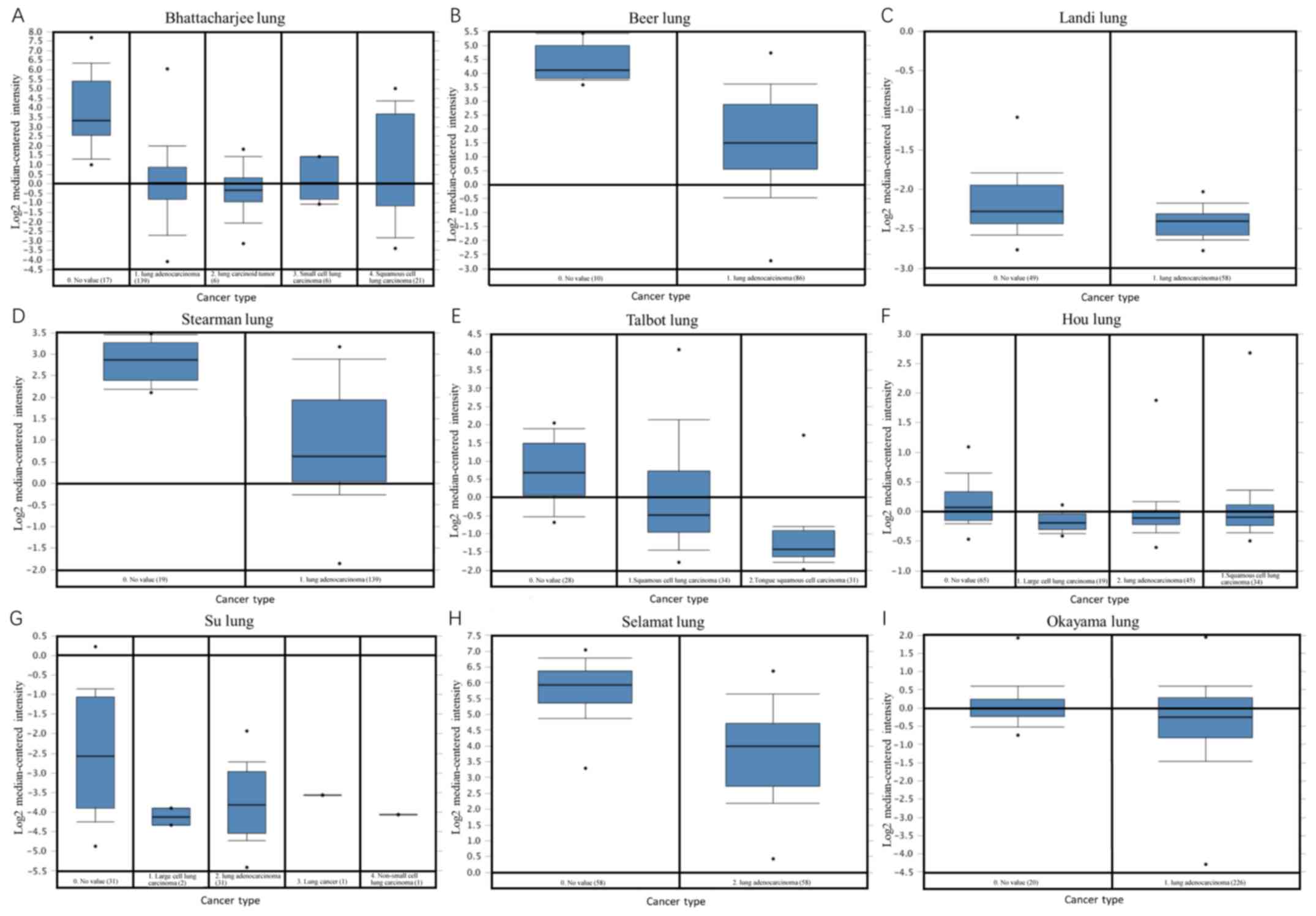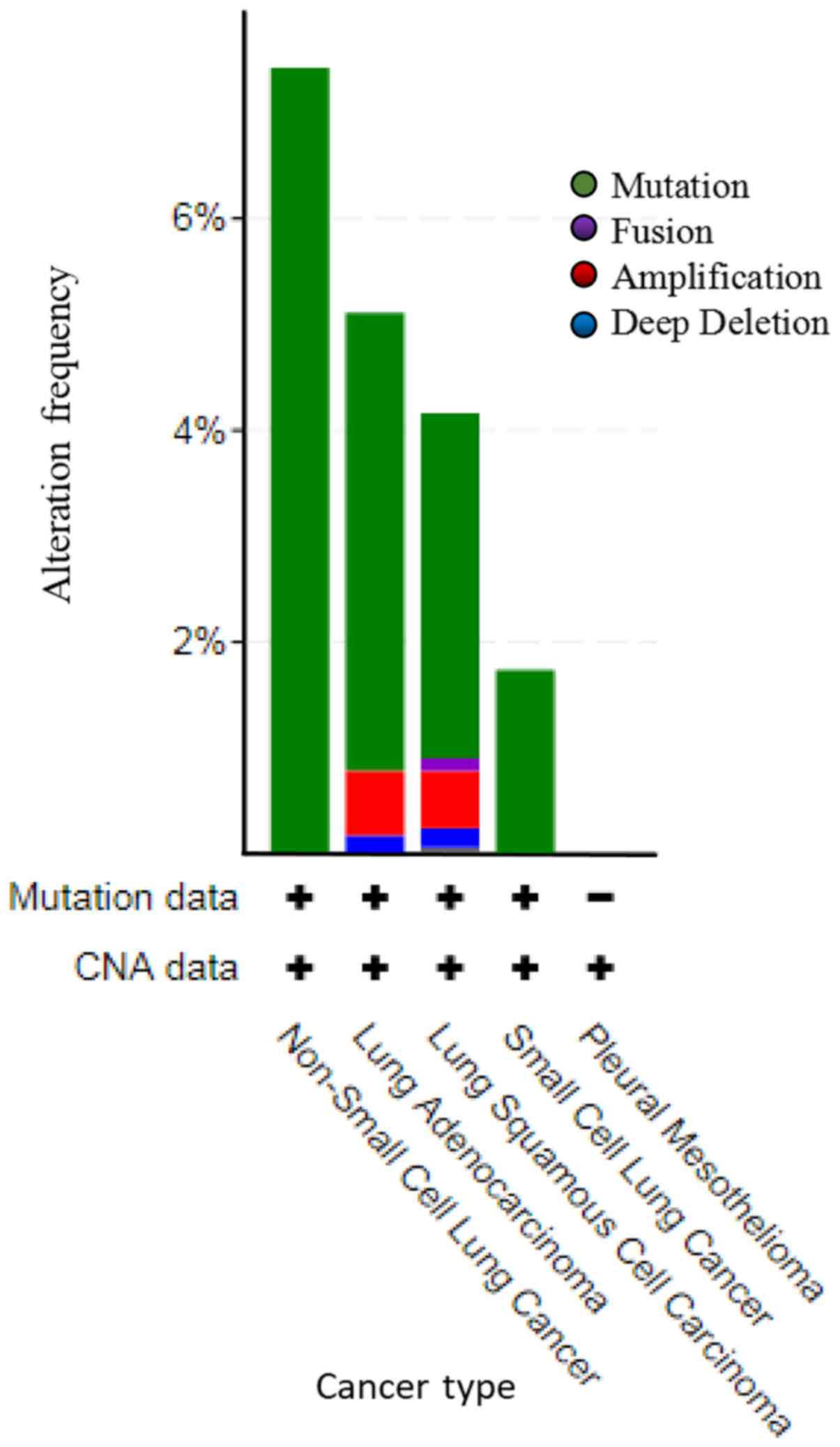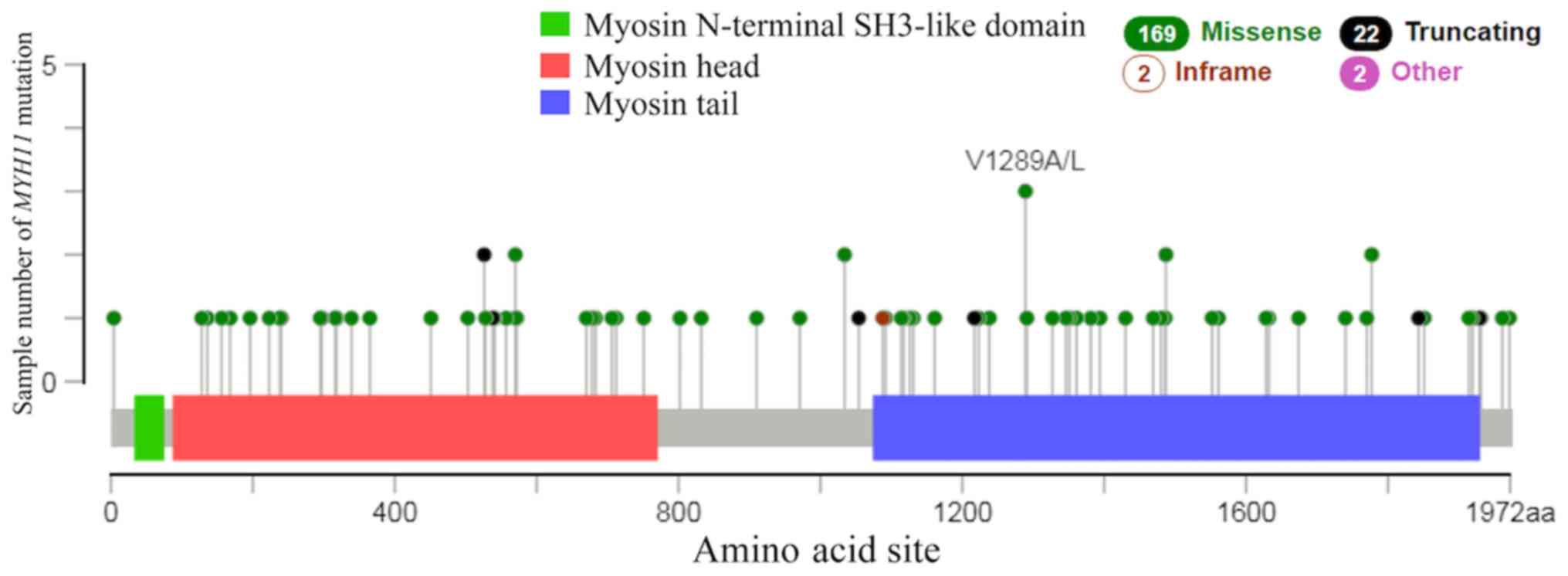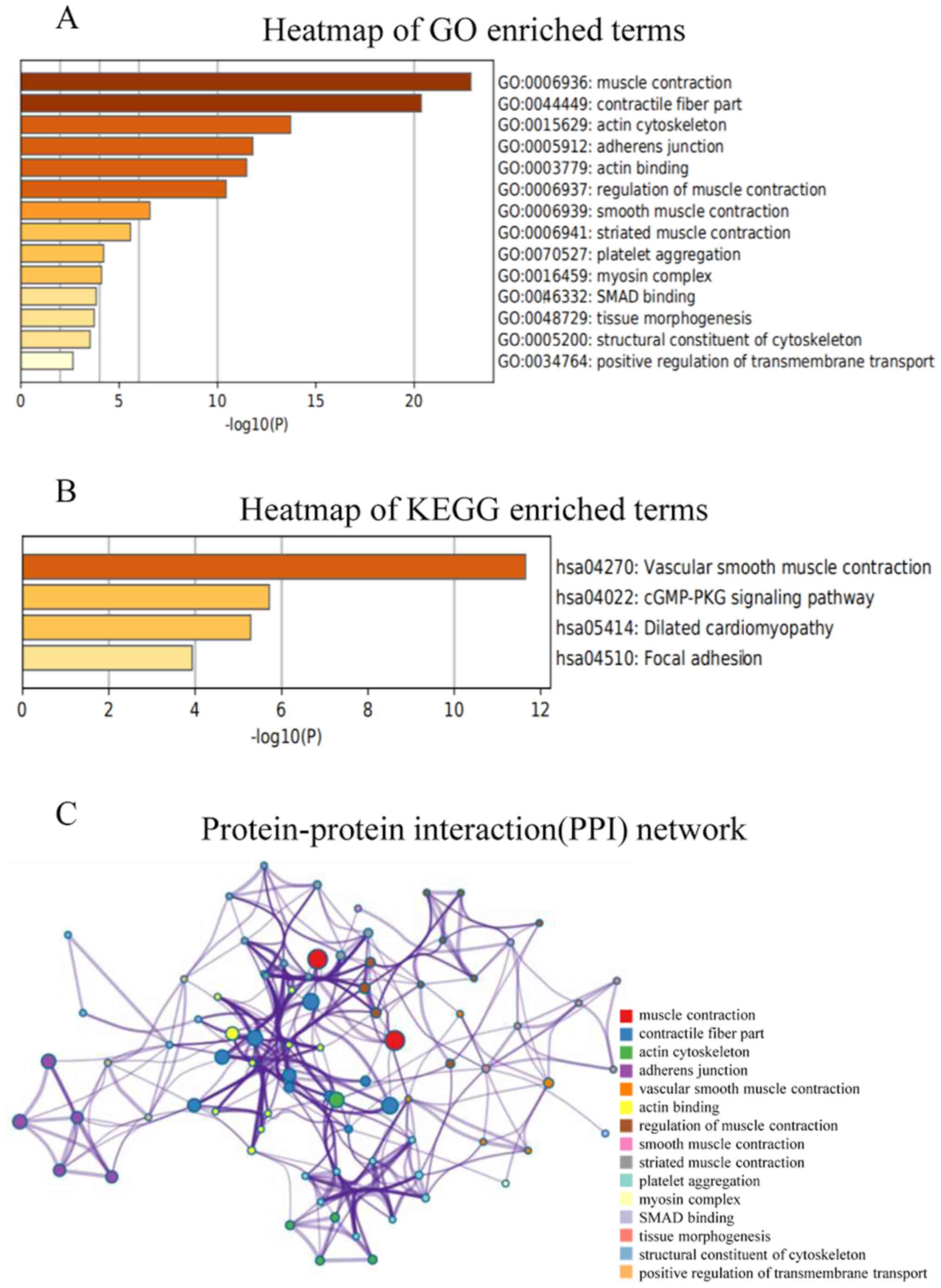Clinical and prognostic significance of MYH11 in lung cancer
- Authors:
- Published online on: March 27, 2020 https://doi.org/10.3892/ol.2020.11478
- Pages: 3899-3906
-
Copyright: © Nie et al. This is an open access article distributed under the terms of Creative Commons Attribution License.
Abstract
Introduction
In 2018, lung cancer was reported as having the highest morbidity and mortality rates of all types of malignancy worldwide, posing a notable risk to human health (1). Although the methods of clinical diagnosis and treatment of lung cancer are improving, the prognosis for patients with lung cancer remains poor. The mortality rate of lung cancer is increasing and the 5-year survival rate is estimated to approximately 18% (2). Therefore, novel targets for drug treatment and prognosis of lung cancer are needed.
Myosin heavy chain 11 (MYH11), which is encoded by the MYH11 gene, is a smooth muscle myosin belonging to the myosin heavy chain family (3). MYH11 is a contractile protein that slides past actin filaments to induce muscle contraction via adenosine triphosphate hydrolysis (4,5). Previous findings have shown that in aortic tissue, destruction of MYH11 can lead to vascular smooth muscle cell loss, disorganization and hyperplasia, which is one of the mechanisms leading to thoracic aortic aneurysms and dissections (6,7). In previous years, studies have indicated that mutations of the MYH11 gene are also associated with various types of cancer, including colorectal (8,9), bladder (10), laryngeal (11) and head and neck cancer (12). This may be due to the role of MYH11 role in cell migration, interaction with cell adhesion proteins and tumor suppression (13,14). However, the association between the expression levels of MYH11 and lung cancer has rarely been investigated. To the best of our knowledge, only Ma et al (15) investigated the key role of MYH11 in non-small-cell lung cancer. In the present study, the Oncomine, Kaplan-Meier plotter, cBioportal, Coexpedia and Metascape databases were used in order to explore the biological significance of MYH11 in lung cancer and provide a scientific basis of the underlying molecular mechanism of MYH11 function in the pathogenesis of lung cancer.
Materials and methods
Oncomine analysis
Oncomine is a large database of cancer microarray experiments and a web-based data-mining platform that is used to screen for differences in gene expression levels between different tumor tissues (16,17). The query terms were set as follows: i) gene: MYH11; and ii) analysis type: Lung cancer vs. normal analysis. P<0.05 was considered to indicate a statistically significant difference, fold change was set to 2 and gene rank to 5%. An unpaired t-test was used for the comparison of two groups.
Kaplan-Meier plotter database
Kaplan-Meier plotter online database (kmplot.com) was used to assess the effects of MYH11 expression levels on survival and prognosis (18). The database was used to query relevant data of lung cancer and the mean expression levels of the gene probes. The correlation between MYH11 expression levels and the survival rate of patients with lung cancer was investigated. P<0.05 was considered to indicate a statistically significant difference. Overall survival, first progression and post progression survival curves were generated using the Kaplan-Meier method and evaluated using the log-rank test.
cBioportal analysis
In order to find mutations and copy number alterations (CNAs) of MYH11, genomic data were retrieved from The Cancer Genome Atlas (TCGA) lung cancer datasets using cBioportal (cbioportal.org) (19). The location and frequency of MYH11 alterations (amplifications, deep deletions and missense mutations) and copy number variance data were assessed.
Coexpedia database
The co-expression genes of MYH11 in Gene Expression Omnibus (GEO) database were analyzed using Coexpedia (coexpedia.org/) (20). Coexpedia is a database of context-associated co-expression networks constructed from individual series of microarray samples for humans. The total score for each gene was the sum of edge-weights (log-likelihood score) and all connected genes in the network.
Metascape analysis
Metascape (metascape.org) is a powerful web-based tool for gene annotation and gene list enrichment analysis, including biological process (BP), molecular function (MF), cellular component (CC) and a Kyoto Encyclopedia of Genes and Genomes (KEGG) pathway analysis (21). In the present study, Metascape was used to conduct a pathway and process enrichment analysis of MYH11 and co-expression genes significantly associated with MYH11 alterations. In addition, protein-protein interaction (PPI) networks were also analyzed.
Results
Expression levels of MYH11 in different types of cancer
In the Oncomine database, a total of 442 studies were available to compare MHY11 gene expression levels between different types of cancer and normal tissues. A total of 68 studies were identified as statistically significant in the Oncomine database. In 64 and 4 studies, MYH11 expression levels were significantly down- and upregulated in cancer tissues compared with normal tissues, respectively. In addition, in 13 studies, decreased MYH11 gene expression levels were noted in lung cancer compared with normal lung tissues (Fig. 1).
Expression of MYH11 in lung cancer
In the Oncomine database, MYH11 gene expression levels in all studies investigating lung cancer were obtained. From November 2001 to the present, thirteen studies met the screening threshold criteria, with a total sample size of 1,122 cases (22–30). As shown in Fig. 2 and Table I, the output results indicated that MYH11 gene expression levels were significantly downregulated in lung cancer tissue compared with normal lung tissue in all 13 studies (median rank=278.0; P=5.38×10−8; Fig. 2).
Table I.Oncomine analysis of 8 datasets analyzing MYH11 gene expression levels in different lung cancer subtypes. The data were compared with the expression levels of MYH11 in normal lung tissues. |
Expression levels of MYH11 in lung cancer subtypes
In the Oncomine database, MYH11 gene expression levels results were derived from 13 studies investigating lung cancer and the relevant data were compared and analyzed using box-plot analysis (Fig. 3). The aforementioned studies included comparisons between different types of lung cancer (squamous cell lung carcinoma, lung adenocarcinoma, small cell lung carcinoma and large cell lung carcinoma) and normal lung tissue (Table I). The results suggested that the MYH11 gene expression levels in different lung cancer subtypes were significantly decreased compared with those noted in normal lung tissue (P<0.05; Table I). Compared with normal lung tissue, the specific output results for the lung adenocarcinoma samples in Bhattacharjee et al (22), Beer et al (23), Landi et al (24), Stearman et al (25), Hou et al (27), Su et al (28), Selamat et al (29) and Okayama et al (30) were 6.39×10−9, 3.17×10−12, 6.23×10−25, 5.14×10−8, 1.7×10−15, 2.72×10-8, 1.62×10−17 and 5.2×10−10, respectively. Compared with normal lung tissues, the p-values were as follows for the squamous cell lung carcinoma samples in Bhattacharjee et al (5.16×10−8) and Talbot et al (26) (5.38×10−8), the small cell lung carcinoma samples in Bhattacharjee et al (22) (1.09×10−5), the lung carcinoid tumor samples in Bhattacharjee et al (22) (3.97×10−9) and the large cell lung carcinoma samples in Hou et al (27) (3.28×10−14).
Correlation between MYH11 expression levels and prognosis of lung cancer
The correlation between MYH11 gene expression levels and lung cancer survival rate were analyzed using the Kaplan-Meier plotter analysis tool (Fig. 4). MYH11 expression levels were positively correlated with overall survival (P=2.2×10−13), first progression (P=8.4×10−8) and post progression survival (P=0.0043) in patients with lung cancer. These results suggested that MYH11 exhibited tumor suppressive roles in lung cancer.
Mutations and CNAs of MYH11 in lung cancer
TCGA datasets of all lung cancer samples were selected to investigate mutations and CNAs in the MYH11 gene. A total of 4,582 cases in 21 studies were included for this analysis (Fig. 5). Among the lung cancer cases with gene alteration of MYH11, mutation was the most common alteration type. A total of 30 cases of non-small cell lung cancer were amplified, accounting for 7.43%. In lung adenocarcinoma, 99 cases were amplified, 14 cases were deep deletion, and 4 cases were fusion, which accounted for 4.32, 0.61 and 0.17%, respectively. In lung squamous cell carcinoma, 54 cases were amplified, 9 cases were deep deletion, 3 cases were fusion and 2 cases were multiple alterations, which accounted for 3.26, 0.54, 0.18 and 0.12%, respectively. A total of 4 cases of small cell lung cancer were amplified, accounting for 1.74% (Fig. 5 and Table II). There were 169 cases of missense, 22 cases of truncating and 2 cases of in-frame mutations in lung cancer (Fig. 6). The results of the present study demonstrated that the most common type of mutation in lung cancer was missense mutation. A previous study reported that MYH11 missense mutations in breast cancer are associated with tumor development (31).
Table II.Mutations and copy number alterations of MYH11 in different types of lung cancer. The alteration frequency of MYH11 in different lung cancer studies. |
Enrichment analysis of MYH11
The visualization of co-expressed genes was ranked according to the online Coexpedia instructions. The total score for each gene was a sum of edge-weights (log likelihood score) and all connected genes in the network. Then, the functions of MYH11 and the 30 genes with the highest scores were predicted by analyzing GO and KEGG data using Metascape (Fig. 7A and B). For GO term enrichment analysis, the target genes were mainly enriched in ‘muscle contraction’, ‘contractile fiber part’, ‘actin cytoskeleton’, ‘adherens junction’, ‘actin binding’, ‘regulation of muscle contraction’, ‘smooth muscle contraction’, ‘striated muscle contraction’, ‘platelet aggregation’, ‘myosin complex’, ‘SMAD binding’, ‘tissue morphogenesis’, ‘structural constituent of cytoskeleton’ and ‘positive regulation of transmembrane transport’ (Fig. 7A). KEGG analysis revealed that the target genes were mostly enriched in ‘vascular smooth muscle contraction’, ‘cGMP-PKG signaling pathway’, ‘dilated cardiomyopathy’ and ‘focal adhesion’ (Fig. 7B). Subsequently, the PPI networks and their connections were identified using Metascape. The results demonstrated that the main functions associated with MYH11 protein were ‘muscle contraction’, ‘contractile fiber part’, ‘actin cytoskeleton’, ‘adherens junction’, ‘vascular smooth muscle contraction’, ‘actin binding’, ‘regulation of muscle contraction’, ‘smooth muscle contraction’, ‘striated muscle contraction’, ‘platelet aggregation’, ‘myosin complex’, ‘SMAD binding’, ‘tissue morphogenesis’, ‘structural constituent of cytoskeleton’ and ‘positive regulation of transmembrane transport’ (Fig. 7C).
Discussion
The MYH11 gene, which encodes a smooth muscle myosin protein, is located at chromosome 16p13.13-13.12 (32). It has been shown that myosin proteins are involved in muscle movement (33). Issouf et al (34) reported that MYH11 is a gene that functions in the molecular mechanisms underlying the contraction of airway smooth muscle in asthma. However, previous studies suggested that MYH11 was also involved in cell adhesion, migration and tumor suppression (13,14). Previous studies demonstrated that mutations in the MYH11 gene could promote cancer formation. For example, the CBFB/MYH11 fusion gene has been implicated in the onset of acute myeloid leukemia (35,36). In addition, MYH11 gene expression levels have been associated with the prognostic outcome of the bladder urothelial carcinoma, notably in patients with advanced tumors (37). Seitz et al (38) demonstrated that MYH11 gene expression levels were downregulated in breast tumor and metastasis, using microarray and correlation analyses. Disregulated MYH11 gene expression levels have also been associated with the occurrence of intestinal tumors by affecting the cellular energy balance (39).
In the present study, MYH11 gene expression levels were significantly decreased in lung cancer tissues compared with that noted in normal lung tissues. These results indicated that the decreased MYH11 gene expression levels were associated with the onset of lung cancer. In addition, decreased MYH11 expression levels were associated with a less favorable prognosis of patients with lung cancer. These results are in accordance with previous studies from Wang et al (9) in colorectal cancer and Ma et al (15) in non-small-cell lung cancer, indicating that MYH11 gene expression levels could be used as a novel biomarker in predicting the prognosis of lung cancer.
Among the lung cancer cases with gene alteration of MYH11, mutation was the most common of all alteration types. Gene-set enrichment analysis showed that the target genes were mainly enriched in ‘muscle contraction’, ‘contractile fiber part’, ‘actin cytoskeleton’ and ‘adherens junction’. It has been proposed that myosin-dependent contractile activity in non-muscle cells, similar to that observed in muscle, may also be involved in cell migration (14). Consistent with these findings, the results of the present study suggest that MYH11 may increase cell migration and adhesion in a mutated manner, in order to increase tumor invasion. In conclusion, the results of the present study demonstrate the potential of MYH11 as a novel target for the treatment of lung cancer. Despite the use of a large sample size, which increases the accuracy of the results, the present study failed to identify the underlying molecular mechanism of MYH11 in the development of lung cancer, thus further verification is required.
Acknowledgements
Not applicable.
Funding
The present study was supported by The Foundation of the Priority Academic Program Development of Jiangsu Higher Education Institutions (grant no. ZYX03KF022), The Fifth ‘333’ Project of Jiangsu Province (grant no. BRA2016522), Subject of Jiangsu Province Hospital of Traditional Chinese Medicine (grant no. Y2017CX55) and The Studio of National famous TCM specialist Liu-ShenLin confirmed by State Administration of Traditional Chinese Medicine.
Availability of data and materials
The datasets used and/or analyzed during the present study are available from the corresponding author upon reasonable request.
Authors' contributions
MN, XP, HT and XZ designed the present study and drafted the initial manuscript. MX, SL, WS and JW interpreted the data. All authors contributed to analyzing the data, and have read and approved the final manuscript.
Ethics approval and consent to participate
Not applicable.
Patient consent for publication
Not applicable.
Competing interests
The authors declare that they have no competing interests.
References
|
Bray F, Ferlay J, Soerjomataram I, Siegel RL, Torre LA and Jemal A: Global cancer statistics 2018: GLOBOCAN estimates of incidence and mortality worldwide for 36 cancers in 185 countries. CA Cancer J Clin. 68:394–424. 2018. View Article : Google Scholar : PubMed/NCBI | |
|
Siegel RL, Miller KD and Jemal A: Cancer statistics, 2018. CA Cancer J Clin. 68:7–30. 2018. View Article : Google Scholar : PubMed/NCBI | |
|
Matsuoka R, Yoshida MC, Furutani Y, Imamura S, Kanda N, Yanagisawa M, Masaki T and Takao A: Human smooth muscle myosin heavy chain gene mapped to chromosomal region 16q12. Am J Med Genet. 46:61–67. 1993. View Article : Google Scholar : PubMed/NCBI | |
|
Huxley AF and Niedergerke R: Structural changes in muscle during contraction: Interference microscopy of living muscle fibres. Nature. 173:971–973. 1954. View Article : Google Scholar : PubMed/NCBI | |
|
Huxley H and Hanson J: Changes in the cross-striations of muscle during contraction and stretch and their structural interpretation. Nature. 173:973–976. 1954. View Article : Google Scholar : PubMed/NCBI | |
|
Zhu L, Vranckx R, Khau Van Kien P, Lalande A, Boisset N, Mathieu F, Wegman M, Glancy L, Gasc JM, Brunotte F, et al: Mutations in myosin heavy chain 11 cause a syndrome associating thoracic aortic aneurysm/aortic dissection and patent ductus arteriosus. Nat Genet. 38:343–349. 2006. View Article : Google Scholar : PubMed/NCBI | |
|
Pannu H, Tran-Fadulu V, Papke CL, Scherer S, Liu Y, Presley C, Guo D, Estrera AL, Safi HJ, Brasier AR, et al: MYH11 mutations result in a distinct vascular pathology driven by insulin-like growth factor 1 and angiotensin II. Hum Mol Genet. 16:2453–2462. 2007. View Article : Google Scholar : PubMed/NCBI | |
|
Xi WD, Liu YJ, Sun XB, Shan J, Yi L and Zhang TT: Bioinformatics analysis of RNA-seq data revealed critical genes in colon adenocarcinoma. Eur Rev Med Pharmacol Sci. 21:3012–3020. 2017.PubMed/NCBI | |
|
Wang RJ, Wu P, Cai GX, Wang ZM, Xu Y, Peng JJ, Sheng WQ, Lu HF and Cai SJ: Down-regulated MYH11 expression correlates with poor prognosis in stage II and III colorectal cancer. Asian Pac J Cancer Prev. 15:7223–7228. 2014. View Article : Google Scholar : PubMed/NCBI | |
|
Hu J, Zhou L, Song Z, Xiong M, Zhang Y, Yang Y, Chen K and Chen Z: The identification of new biomarkers for bladder cancer: A study based on TCGA and GEO datasets. J Cell Physiol. Feb 18–2019.(Epub ahead of print). View Article : Google Scholar | |
|
Su J, Zhang Y, Su H, Zhang C and Li W: A recurrence model for laryngeal cancer based on SVM and gene function clustering. Acta Otolaryngol. 137:557–562. 2017. View Article : Google Scholar : PubMed/NCBI | |
|
Islam T, Rahman R, Gov E, Turanli B, Gulfidan G, Haque A, Arga KY and Haque Mollah N: Drug targeting and biomarkers in head and neck cancers: Insights from systems biology analyses. OMICS. 22:422–436. 2018. View Article : Google Scholar : PubMed/NCBI | |
|
Krendel M and Mooseker MS: Myosins: Tails (and Heads) of functional diversity. Physiology (Bethesda). 20:239–251. 2005.PubMed/NCBI | |
|
Pollard TD and Weihing RR: Actin and myosin and cell movemen. CRC Crit Rev Biochem. 2:1–65. 2008. View Article : Google Scholar | |
|
Ma Q, Xu Y, Liao H, Cai Y, Xu L, Xiao D, Liu C, Pu W, Zhong X and Guo X: Identification and validation of key genes associated with non-small-cell lung cancer. J Cell Physiol. 234:22742–22752. 2019. View Article : Google Scholar : PubMed/NCBI | |
|
Findeisen P, Röckel M, Nees M, Röder C, Kienle P, Von Knebel Doeberitz M, Kalthoff H and Neumaier M: Systematic identification and validation of candidate genes for detection of circulating tumor cells in peripheral blood specimens of colorectal cancer patients. Int J Oncol. 33:1001–1010. 2008.PubMed/NCBI | |
|
Rhodes DR, Kalyana-Sundaram S, Mahavisno V, Varambally R, Yu J, Briggs BB, Barrette TR, Anstet MJ, Kincead-Beal C, et al: Oncomine 3. 0: Genes, pathways, and networks in a collection of 18, 000 cancer gene expression profiles. Neoplasia. 9:166–180. 2007. View Article : Google Scholar : PubMed/NCBI | |
|
Nagy A, Lánczky A, Menyhárt O and Győrffy B: Validation of miRNA prognostic power in hepatocellular carcinoma using expression data of independent datasets. Sci Rep. 8:92272018. View Article : Google Scholar : PubMed/NCBI | |
|
Gao J, Aksoy BA, Dogrusoz U, Dresdner G, Gross B, Sumer SO, Sun Y, Jacobsen A, Sinha R, Larsson E, et al: Integrative analysis of complex cancer genomics and clinical profiles using the cBioPortal. Sci Signal. 6:pl12013. View Article : Google Scholar : PubMed/NCBI | |
|
Yang S, Kim CY, Hwang S, Kim E, Kim H, Shim H and Lee I: COEXPEDIA: Exploring biomedical hypotheses via co-expressions associated with medical subject headings (MeSH). Nucleic Acids Res. 45:D389–D936. 2017. View Article : Google Scholar : PubMed/NCBI | |
|
Shannon P, Markiel A, Ozier O, Baliga NS, Wang JT, Ramage D, Amin N, Schwikowski B and Ideker T: Cytoscape: A software environment for integrated models of biomolecular interaction networks. Genome Res. 13:2498–2504. 2003. View Article : Google Scholar : PubMed/NCBI | |
|
Bhattacharjee A, Richards WG, Staunton J, Li C, Monti S, Vasa P, Ladd C, Beheshti J, Bueno R, Gillette M, et al: Classification of human lung carcinomas by mRNA expression profiling reveals distinct adenocarcinoma subclasses. Proc Natl Acad Sci USA. 98:13790–13795. 2001. View Article : Google Scholar : PubMed/NCBI | |
|
Beer DG, Kardia SL, Huang CC, Giordano TJ, Levin AM, Misek DE, Lin L, Chen G, Gharib TG, Thomas DG, et al: Gene-expression profiles predict survival of patients with lung adenocarcinoma. Nat Med. 8:816–824. 2002. View Article : Google Scholar : PubMed/NCBI | |
|
Landi MT, Dracheva T, Rotunno M, Figueroa JD, Liu H, Dasgupta A, Mann FE, Fukuoka J, Hames M, Bergen AW, et al: Gene expression signature of cigarette smoking and its role in lung adenocarcinoma development and survival. PLoS One. 3:e16512008. View Article : Google Scholar : PubMed/NCBI | |
|
Stearman RS, Dwyer-Nield L, Zerbe L, Blaine SA, Chan Z, Bunn PA Jr, Johnson GL, Hirsch FR, Merrick DT, Franklin WA, et al: Analysis of orthologous gene expression between human pulmonary adenocarcinoma and a carcinogen-induced murine model. Am J Pathol. 167:1763–1775. 2005. View Article : Google Scholar : PubMed/NCBI | |
|
Talbot SG, Estilo C, Maghami E, Sarkaria IS, Pham DK, O-charoenrat P, Socci ND, Ngai I, Carlson D, Ghossein R, et al: Gene expression profiling allows distinction between primary and metastatic squamous cell carcinomas in the lung. Cancer Res. 65:3063–3071. 2005. View Article : Google Scholar : PubMed/NCBI | |
|
Hou J, Aerts J, den Hamer B, van Ijcken W, den Bakker M, Riegman P, van der Leest C, van der Spek P, Foekens JA, Hoogsteden HC, et al: Gene expression-based classification of non-small cell lung carcinomas and survival prediction. PLoS One. 5:e103122010. View Article : Google Scholar : PubMed/NCBI | |
|
Su LJ, Chang CW, Wu YC, Chen KC, Lin CJ, Liang SC, Lin CH, Whang-Peng J, Hsu SL, Chen CH and Huang CY: Selection of DDX5 as a novel internal control for Q-RT- PCR from microarray data using a block bootstrap re-sampling scheme. BMC Genomics. 8:1402007. View Article : Google Scholar : PubMed/NCBI | |
|
Selamat SA, Chung BS, Girard L, Zhang W, Zhang Y, Campan M, Siegmund KD, Koss MN, Hagen JA, Lam WL, et al: Genome-scale analysis of DNA methylation in lung adenocarcinoma and integration with mRNA expression. Genome Res. 22:1197–1211. 2012. View Article : Google Scholar : PubMed/NCBI | |
|
Okayama H, Kohno T, Ishii Y, Shimada Y, Shiraishi K, Iwakawa R, Furuta K, Tsuta K, Shibata T, Yamamoto S, et al: Identification of genes upregulated in ALK-positive and EGFR/KRAS/ALK-negative lung adenocarcinomas. Cancer Res. 72:100–111. 2012. View Article : Google Scholar : PubMed/NCBI | |
|
Alhopuro P, Karhu A, Winqvist R, Waltering K, Visakorpi T and Aaltonen LA: Somatic mutation analysis of MYH11 in breast and prostate cancer. BMC Cancer. 8:2632008. View Article : Google Scholar : PubMed/NCBI | |
|
Deng Z, Liu P, Marlton P, Claxton DF, Lane S, Callen DF, Collins FS and Siciliano MJ: Smooth muscle myosin heavy chain locus (MYH11) maps to 16p13.13-p13.12 and establishes a new region of conserved synteny between human 16p and mouse 16. Genomics. 18:156–159. 1993. View Article : Google Scholar : PubMed/NCBI | |
|
Trybus KM: Regulation of smooth muscle myosin. Cell Motil Cytoskeleton. 18:81–85. 1991. View Article : Google Scholar : PubMed/NCBI | |
|
Issouf M, Vargas A, Boivin R and Lavoie JP: SRSF6 is upregulated in asthmatic horses and involved in the MYH11 SMB expression. Physiol Rep. 6:e138962018. View Article : Google Scholar : PubMed/NCBI | |
|
Goyama S and Mulloy JC: Molecular pathogenesis of core binding factor leukemia: Current knowledge and future prospects. Int J Hematol. 94:126–133. 2011. View Article : Google Scholar : PubMed/NCBI | |
|
Liu P, Tarlé SA, Hajra A, Claxton DF, Marlton P, Freedman M, Siciliano MJ and Collins FS: Fusion between transcription factor CBF beta/PEBP2 beta and a myosin heavy chain in acute myeloid leukemia. Science. 261:1041–1044. 1993. View Article : Google Scholar : PubMed/NCBI | |
|
Ning X and Deng Y: Identification of key pathways and genes influencing prognosis in bladder urothelial carcinoma. Onco Targets Ther. 10:1673–1686. 2017. View Article : Google Scholar : PubMed/NCBI | |
|
Seitz S, Korsching E, Weimer J, Jacobsen A, Arnold N, Meindl A, Arnold W, Gustavus D, Klebig C, Petersen I and Scherneck S: Genetic background of different cancer cell lines influences the gene set involved in chromosome 8 mediated breast tumor suppression. Genes Chromosomes Cancer. 45:612–627. 2010. View Article : Google Scholar | |
|
Alhopuro P, Phichith D, Tuupanen S, Sammalkorpi H, Nybondas M, Saharinen J, Robinson JP, Yang Z, Chen LQ, Orntoft T, et al: Unregulated smooth-muscle myosin in human intestinal neoplasia. Proc Natl Acad Sci USA. 105:5513–5518. 2008. View Article : Google Scholar : PubMed/NCBI |
















